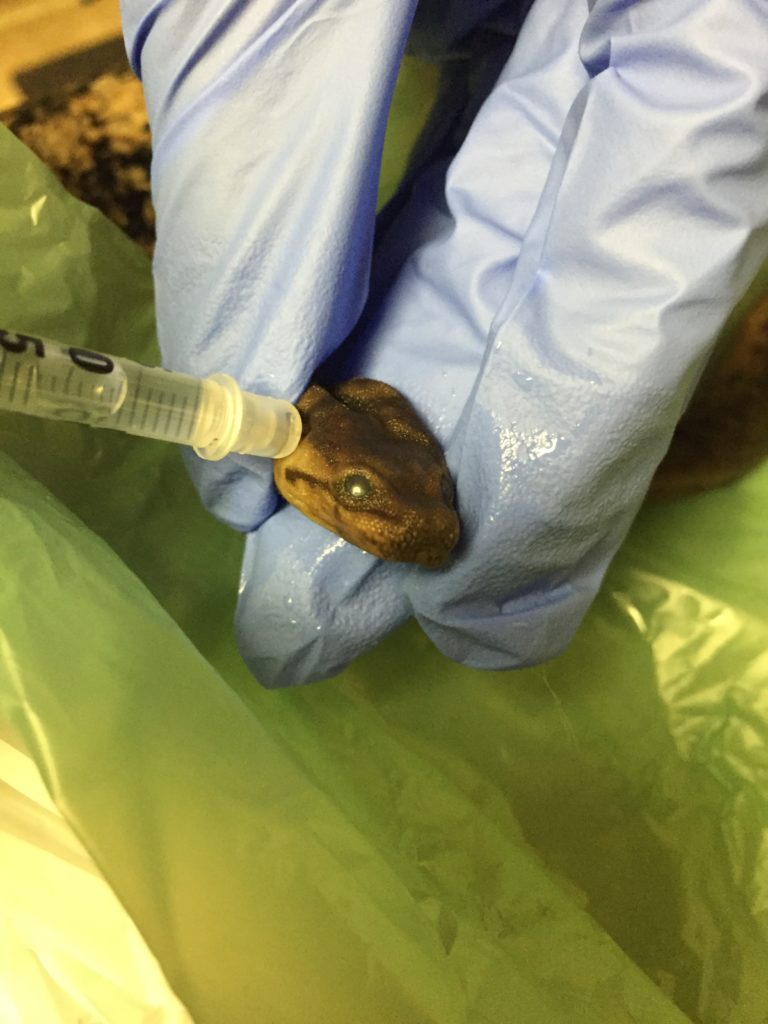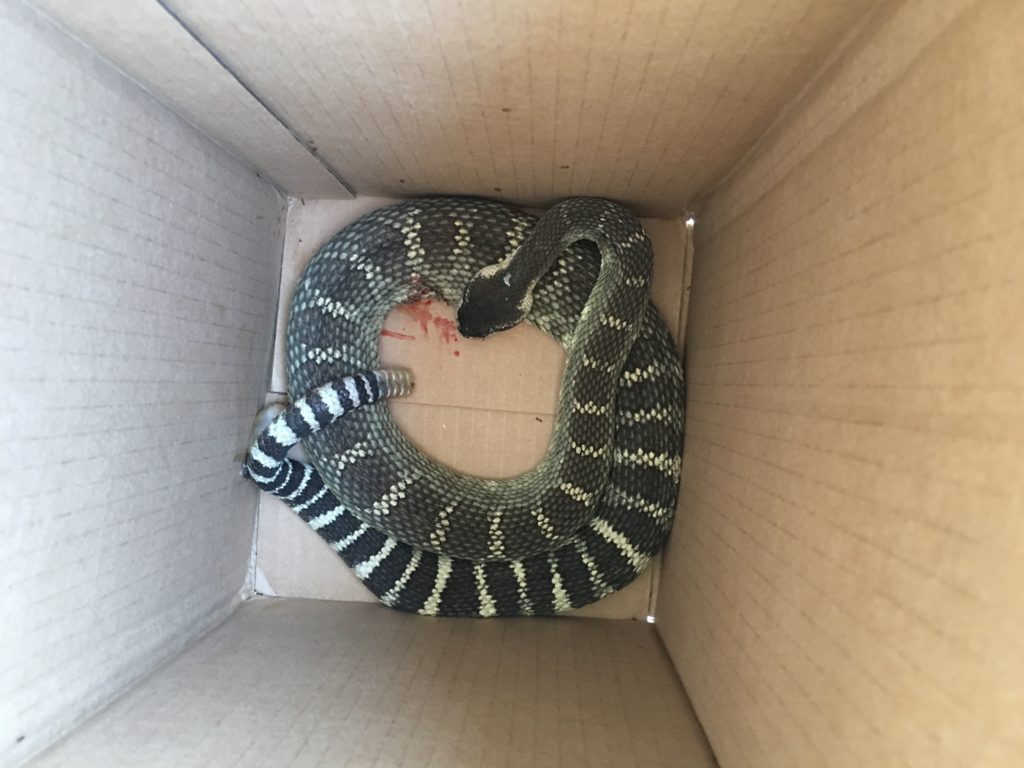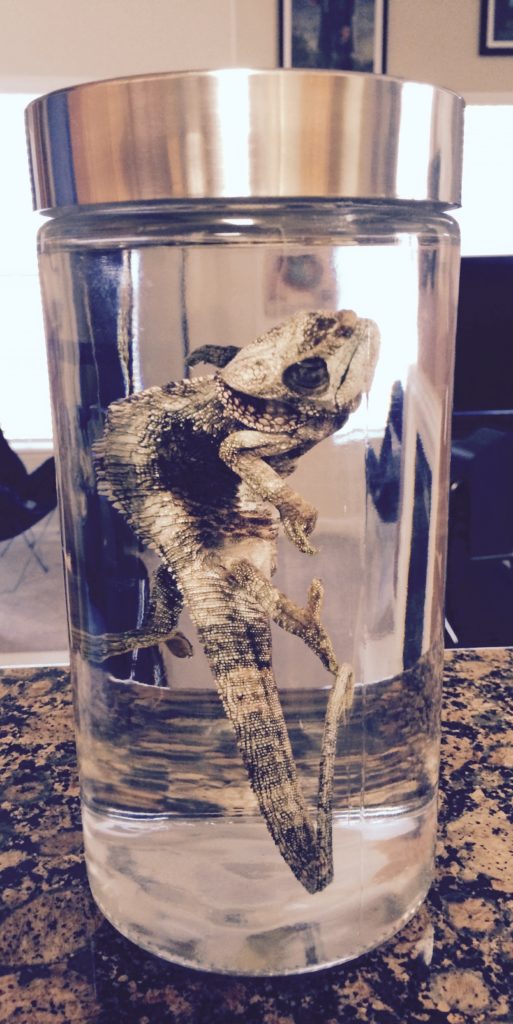How To Preserve A Snake In A Jar
Nosotros'd like to preface this blog article by stating that it's never a happy occasion when a pet reptile or amphibian passes. It's a lamentable occurrence and we'd like to brand it known before you delve into this piece that nosotros're not writing this tutorial with an attitude of callousness or disregard for the lives of the beautiful reptiles and amphibians with which we gratefully share our homes.
We as well desire to state that this post will be somewhat graphic and depict photos of deceased reptiles and amphibians being preserved. To some people, this might be agonizing and we wish to alert those with sensitive constitutions of this fact earlier they go on reading.
All of the Backwater Reptiles squad loves reptiles, amphibians, and invertebrates and we are writing this commodity from a place of appreciation for these wonderful animals and the enrichment they bring to our lives. Nosotros're of the mindset that fifty-fifty after they've passed, our loving pets might live on through the preservation procedure, but nosotros definitely empathise that not everyone wishes to see their dearly departed pet after they have moved on.
And so now that nosotros've warned you that the content of this post is not going to be appealing to anybody, let the states continue forward. We'll discuss everything from how to humanely euthanize a reptile or amphibian to how to safely create a wet specimen or dry out specimen out of an brute that has moved on due to natural causes.

How to humanely euthanize an sick or dying reptile or amphibian
It'south never an easy conclusion to euthanize a pet, no matter what type of animal you care for. It's natural to grow fastened to your pet, no matter if it has scales or fur.
It's standard operating process to take a dying or ill true cat, dog or other domestic creature to the vet to be euthanized, but what do y'all practise when that pet is a reptile or amphibian? Is the procedure the same? What is the most humane mode to go about helping your reptile over the rainbow bridge?
Patently, we always recommend taking your reptile to the vet when it comes fourth dimension to brand such a tough decision. Although there are ways to exercise then at dwelling, they are controversial and we feel that information technology'south e'er all-time to leave such matters in the hands of professionals, so nosotros won't be touching upon these methods, even though some people might endorse them.
Your herp veterinarian knows how your pet'south trunk works and will be able to euthanize your herp in a mode that alleviates pain and causes the to the lowest degree distress to the animate being and to the owner. Some vets are fifty-fifty kind enough to perform business firm calls for an additional fee.
How to create a wet specimen from a deceased reptile or amphibian
Before we delve into the process of preserving your reptile or amphibian as a wet specimen, we should probably explain what exactly a moisture specimen is.
Different mounted skeletons or taxidermy, which both require extensive studying and experience to perform, moisture specimens are animals suspended in a liquid matrix in some sort of container such equally a jar or a canteen. The liquid can range from ethyl alcohol to formalin, just either way, it will substantially "pickle" the brute in question, preserving it in its entirety.
For the purposes of this article, because we're not experts on the subject area, we'll stick strictly to preserving a complete specimen. In other words, it is certainly possible to preserve parts and pieces of an animal, but we're only discussing capturing the essence of an unabridged animate being prior to its decomposition process.
When creating a moisture specimen, it'southward best to starting time right away. The less rigor mortis that sets in, the better you tin can pose your animal into a resting position that yous similar. Still, if you are unable to begin the preservation process right away, you lot tin store your reptile or amphibian in the freezer.
Only keep in heed that freezing works better on animals with scales as the porous skin of amphibians can actually become freezer burn if you're not conscientious.

List of supplies needed to create a wet specimen
–A jar or container big plenty to hold the reptile or amphibian that you volition be preserving.This is a no-brainer. You'll need something to concur both the liquid and the beast in question.
When nosotros've created specimens in the by, we've purchased glass jars with either twist top silver lids or vacuum sealed glass tops. Pretty and decorative jars and containers can be found in abundance at thrift stores for very inexpensive or you can head to your local craft store for a wide range of sizes. But be sure your container is glass because plastic can react poorly with chemicals.
Side notation: Although jars with cork lids definitely look appealing and will do the play a trick on for a short amount of time, the cork lid is porous and you lot will lose preservative through information technology over time. So although y'all tin can certainly cap your container with cork, keep in listen that you'll take to refill your jar with preservative from time to fourth dimension.
–Preservative liquid . Again, our preservatives of choice are either formalin or ethyl alcohol, although there are others that you can use if yous know where to find them.
Ethyl alcohol is a clear alcohol much like rubbing alcohol, however its chemic composition is slightly different. We use a solution of at to the lowest degree 70% alcohol to water that can easily be purchased from any drug store.
Formalin is a chip trickier to work with and is actually a carcinogen, so we recommend using ethyl alcohol if at all possible, even though it is not as strong of a preservative.
Formalin is not every bit easy to secure due to the forcefulness of the chemical, but it can be purchased online.
No thing whether you lot choose to use ethyl alcohol, formalin, or some other chemical, be sure that you accept enough to inject your animate being and enough to fill your holding container.
–Needles in syringes. Depending on the size of the reptile or amphibian y'all're preserving, you'll need diverse gauges of needle, just for most animals, the very small hypodermic syringes used by diabetics work simply fine.
If you lot need needles larger than insulin syringes contain, y'all can lodge them online. However, insulin syringes can be purchased at any pharmacy in bulk for relatively cheap.
–Plastic sheet liner . This item is non necessary, merely we prefer to line our work space with some trash bags or dispensable plastic bags just to keep things every bit sanitary as possible.
–Gloves . Hither's some other detail that is non strictly needed, simply we certainly adopt to utilise when available for sanitary reasons.
You tin wearable latex or prophylactic gloves, but either mode, we cull gloves that are fairly fitted to the peel. This is because a lot of the needlework tin can crave a delicate touch and oversized bulky gloves can make this difficult.
Steps to creating a wet specimen
1. Thaw your reptile or amphibian if necessary. You lot will be injecting it with a preservative liquid, so if possible, yous'll want the animal to exist soft to the touch and pliable, rather than strong and frozen.
two. Empty a small-scale amount of your preservative liquid of choice into a bowl or temporary belongings container. You lot will be sucking upwards the liquid into your syringe very ofttimes, then we've found it's easiest to have the liquid in an open container where your needles have easy access to it.
3. Uncap your syringe(due south) and fill it with preservative. Begin either at the tail end of the animal or at the head and start injecting the preservative. Considering your brute however contains all its internal organs, you lot'll want to get your needles far enough into the torso cavities so that the preservative is reaching those organs.
4. Inject your reptile or amphibian's trunk cavities until you feel that it is total enough of preservative. This means getting within the attic, the abdomen, and even inside the cloaca if necessary.

In that location'southward not actually a way to be one hundred percent certain that your specimen is done being filled. It's sort of something you judge by examining and feeling the creature itself. It should begin to "fill out" and sometimes you can even feel the preservative within to know where yous need more.
v. Position your reptile of amphibian inside the container in a position yous desire it to remain. Many animals will gently float within the preservative liquid, while others, like snakes, can be coiled up within the jar.
six. Fill the property container up with enough preservative to cover the reptile or amphibian. If your creature is floating, we recommend filling the entire container up to the chapeau, otherwise you tin just fill up it enough to comprehend your specimen.
seven. Put the lid on your container and your moisture specimen is set up to display! We would like to mention that oftentimes times, the start liquid you fill your jar with volition need to be drained and replaced after a few weeks. It'south not uncommon for the liquid to be discolored when the brute is "settling in" then to speak, but you can e'er drain and replace if you want pristine, articulate preservative liquid.
How to create a "dry" specimen from a deceased reptile or amphibian
Transforming your pet or other humanely sourced reptile or amphibian into a dry specimen through methods such as articulation, taxidermy, mummification, or another similar practice is far more complicated than producing a moisture specimen. And quite honestly, it takes a far more practiced and knowledgeable individual to perform such tricky jobs. Therefore, for the purposes of this weblog article, nosotros'll but affect upon how to catechumen your creature into a make clean set of bones.

At that place is always the old fashioned method of burying the animal and allowing nature to run its course. You can ever put your deceased fauna into a shoebox or other type of container, bury it for a few months, allow the creepy crawlies do their chore, and unearth the container later.
Personally, although a simple burial is the most hassle free approach, we adopt faster methods. Not simply can information technology take some time for your specimen to decompose depending on the size of the animal, just there is always the adventure that something could go wrong. For case, if your burial ground is not confined to say, your backyard, hungry wildlife tin can and volition come along and dig upwards your animal. And so you lot've likely lost your specimen altogether.
Nosotros adopt to clean the deceased brute ourself and feed the remains to dermestid beetles. These are a special type of insect that feed upon decomposable flesh. They volition essentially make clean your animal of its skin and other material in a matter of days, leaving you with clean bones.
In that location are many sources where yous can purchase dermestid beetles, but pretty much all of them volition be online. We recommend purchasing from a seller who has a rails record and instructions on how to feed the beetles because this means they have experience and likely won't sell you beetles with parasites.
Once you've acquired your beetles and created a habitat for them, you lot will demand to pare your animal, especially if it is a ophidian. Amphibians are a bit easier to work with and won't crave as much work.
The beetles prefer drier meals, so if you are able to safely allow your specimen to dry out for a day or 2 prior to placing it in the beetle'south enclosure, they will make quicker work of the carcass.
Please be aware that with small animals like frogs, delicate lizards, and other tiny reptiles or amphibians, you might just cease up with a skull left over. Sometimes the bones of the body are also delicate or cartilaginous to survive this procedure.
You can certainly clean your animal to the all-time of your power of its internal organs and skin and boil information technology likewise. However, we actually don't recommend this method for reptiles every bit the basic tend to be then minor and delicate that it can be quite a tricky process and might ruin your bones.
Reptile and amphibian skeletons
If you're merely looking for the skeleton to be preserved, there are cleaner insects called dermestid beetles that clean expressionless animal carcasses to the bone. It's a fairly clean process, and the beetles can be purchased online.
Determination
There are many ways to preserve and memorialize your pet reptile or amphibian. Whether yous choose to endeavour to transform them into a wet specimen or merely save their basic, please continue in heed that this article is a beginner's guide and not an expert tutorial.

Conclusion: How To Preserve A Reptile Or Amphibian
If yous truly want your beast'due south likeness preserved in the well-nigh constructive mode possible, we recommend finding a specialist in your area that has experience in such matters.
Source: https://backwaterreptilesblog.com/preserve-deceased-reptile-amphibian/

0 Response to "How To Preserve A Snake In A Jar"
Post a Comment